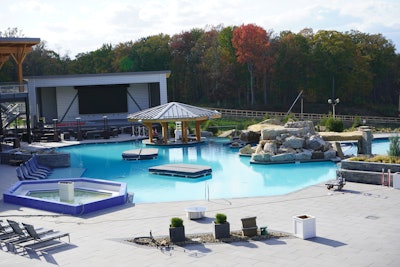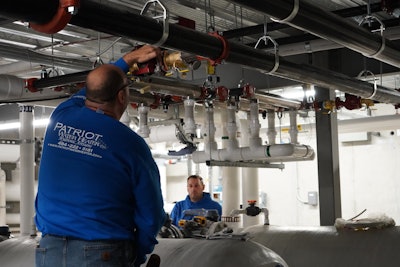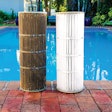
Closer to the intersection of the Pennsylvania, West Virginia and Maryland borders than any city, Farmington, Pa., is an unlikely place for a five-star resort, but the area offers a serene mountain escape within easy driving distance of Pittsburgh. Frankly, it’s perfect for world-class accommodations.
Since Nemacolin Woodlands Resort’s inception in 1987, the exceedingly-lavish resort has grown to include a private airport, golf course, ski resort, zoo, and accommodations ranging from single-room lodging to estates that demand $20,000 per night. Luxury at this level might be expected in Dubai or the highest penthouses in Las Vegas, but not in the timbered, rolling countryside of the Appalachian Mountains. Surprise…
The entire 2,200-acre property is open year round, but between fall and spring, The Winter Wonderland at The Peak is the place to be, and to be seen. This ski resort within Nemacolin is complete with heated outdoor pools and spas, and offers every imaginable winter activity, from dog sled rides to snow tubing.
The Peak is the newest portion of the resort. Its grand opening was held over the July 4th weekend in 2021. Needless to say, early 2021 was a difficult time for major construction projects. Material and manpower challenges were compounded by the need to limit the number of people on a jobsite.
“To make the project more complicated, the timeline was exceedingly tight,” says Tom Soukup, owner of Patriot Water Works, the pool heating specialists hired to design and install the high-efficiency system that conditions four bodies of water on the property.
 (L-R) Tom Soukup, owner of Patriot Water Works, and Rich Zalepa, service manager, prepare to commission the new pool heating system.
(L-R) Tom Soukup, owner of Patriot Water Works, and Rich Zalepa, service manager, prepare to commission the new pool heating system.
Professional Problem Solving
In late February of 2021, Soukup was referred to Nemacolin by Dave Raabe, at manufacturer’s rep firm ROI Marketing. Raabe had discussed the project with Nemacolin’s aquatic designer, who had originally planned to heat the pool complex with a pair of commercial steam boilers.
“I knew that the facility would need a great deal of heat, that their mechanical space was limited, and that the design would be critical for proper performance,” says Raabe. “Because of my experience with Patriot, I knew they’d be one of the best firms in the country to handle the work at Nemacolin.”
Patriot Water Works serves the Mid-Atlantic, conducting new and retrofit pool heating installations for retirement facilities, condo and apartment complexes, resorts, hotels and water parks.
The scale of Nemacolin’s pool complex is by no means the largest Patriot has worked on, but the heating capacity needed to keep the water at setpoint temperature may be the most required on any previous Patriot project, simply because all of the water surface is outside.
The 80,000-gallon main pool features multiple grottos and a swim-up bar. It’s maintained at 87 degrees Fahrenheit year-round. The 133,000-gallon “Lazy River” is reduced to 40 degrees Fahrenheit through the ski season to save energy while avoiding the need for winterization. The larger of the two spas, at 2,500 gallons, is constantly 101 degrees Fahrenheit, while the smaller, 700-gallon spa is turned down for winter. The entire pool area is surrounded by 14,000 square feet of snow-melted paver surface.
“The resort’s initial goal was to heat all the pools year-round, and to have the entire system complete by early July,” says Soukup. “They knew their natural gas consumption would be tremendous, and wanted to mitigate that to whatever degree possible. Between using cascaded, modulating hydronic boilers in place of steam boilers, and by reducing the wintertime temperature on one spa and one pool, we helped steer the resort toward the energy goals they had in mind.”
Soukup was also very transparent about the projected timeline. Despite Patriot’s expertise and the resort’s use of a very capable concrete, plumbing and electrical subcontractors, Soukup explained that there was simply no way to create the aquatic facility and complete the heating system by early July for the grand opening. He did, however, present a solid alternative.
“I explained that we could maintain the desired water temperatures for the grand opening with a much smaller, temporary system,” he says. “With higher ambient air temps and no need to provide snow melting for the pavers, the heat load in July is a fraction of what’s needed at winter design conditions.”
There are countless variables when designing a pool heating system, but those related to heat loss specifically include the surface area and depth of water, outdoor ambient temperature, wind load and precipitation.
Building Better
When Patriot arrived, much of the filtration and water treatment had been installed. Installing large steam boilers and piping would have been nearly impossible. Soukup’s design included the use of more numerous, smaller hydronic boilers and heat exchangers.
“We utilize stainless steel condensing boilers on all our installations,” he explains. “This has consistently proven to reduce maintenance, lower fuel consumption and greatly improve controllability and system longevity. It’s quite different from the industry norm — which includes conventional, gas-fired pool heaters or steam boilers on very large installations like this one — but it works exceptionally.”
After the temporary system was installed, Patriot technicians began assembling the permanent system components. Eight, 800 MBH Alpine condensing boilers, made by U.S. Boiler Company, are stacked two high. Ten E J Bowman titanium heat exchangers, ranging from 360 MBH to 1.2 MMBTU, serve the various bodies of water. The heat exchangers ensure that pool water, and the chemicals that it contains, is never introduced to the boiler loop.
“The steam boilers in the original design were rated at 82% efficiency,” says Soukup. “The Alpine boilers we use are rated at 95% efficiency, for a savings of 13% right off the bat. You also need to consider that the steam boilers are “on-off” units, meaning that they only have one firing rate: high. Because the proposed system featured two boilers, the total system had two stages of input: either one steam boiler firing, or both. Even if only the small spa called for heat, half of the system’s firing capacity would have come online. That’s extremely wasteful, and hard on the boiler to fire for such a short period.”
Each of the Alpine boilers installed by Patriot has five stages of input, yielding a total system turndown ratio of 40-to-one. The boilers ramp up or down as needed, never exceeding the firing capacity that’s actually needed by the facility. The multiple boiler, multiple heat exchanger approach also provides a great deal of redundancy, should one unit fail or require service.
In addition to providing heat for the pools, spas and snowmelt system, the boiler system also provides domestic hot water at The Peak. This includes family locker rooms, 12 individual lavatories and a galley kitchen and bar. To accomplish this, Patriot installed a Thermal Solutions H2OMax commercial hot water heat exchanger, which boasts energy savings of 30 to 40% over conventional water heaters.
Experience Yields Agility
The timeline, impacts of the pandemic, and the unique requirements on the job made the work at Nemacolin more complicated than most pool heating applications.
“This project made me extremely thankful that we have the experience needed to remain agile,” says Rich Zalepa, Patriot project manager and site supervisor at Nemacolin. “There were several instances where we needed to pivot quickly due to the product being indefinitely backordered, but yet we couldn’t let a change on-the-fly impact the quality of the product.”
Patriot would typically have used fewer, larger titanium heat exchangers. This would have saved some time spent piping. To accommodate the use of smaller heat exchangers, Patriot fabricated arrays to keep the units lined up nicely on the wall.
“Using more numerous, smaller heat exchangers didn’t put us at a disadvantage,” says Zalepa. “In fact, they offered more redundancy and lower pumping head loss. Because of this, we were able to use smaller circulators, providing some electrical savings.”
Some control components were also unavailable, specifically the expansion cards that allowed the heating system to receive input from the thermostats on the water treatment system.
“We didn’t intend to have a separate set of thermostats, but our work-around was to use Ranco thermostats on each body of water, communicating directly with the boilers,” explains Zalepa. “The controls on the Alpine boiler are extremely capable, if you know how to use them.”
The pools were filled four days before the July grand opening and Patriot balanced the system for temporary use. By Labor Day, the permanent system had been commissioned.
The resort has been thrilled with the performance of the new system. No callbacks have come in, and water temperatures are maintained within half a degree of setpoint, regardless of outdoor conditions. This is vitally important because water temperature has an impact on the amount of pool treatment chemicals needed. Additionally, the new system provides a calculated energy savings of over $22,000 dollars per year at current natural gas prices.
“We worked hand-in-hand with a number of skilled subcontractors on this job,” says Soukup. “This is critical on any design-build job, but especially here, with a compressed timeline. At the end of the day, I think one of the most important attributes of any professional is the ability to listen to the customer and critically help them address their goals and concerns during the design process. I think this job illustrates that.”
Tom Soukup is the principal of Patriot Water Works Co. with over 20 years as a hydronic designer and installer. He specializes in high-efficiency and green technology and brings his expertise to custom hydronic work, pool heating and agricultural projects. Reach him at: [email protected]











































